
|
|
6 December, 2001
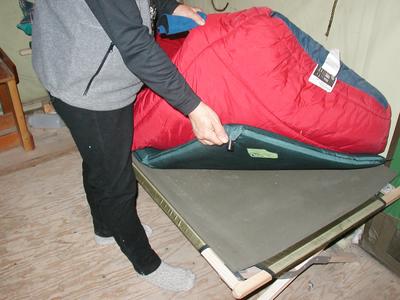
As I packed my things to leave, I quickly took a picture of my cot with the pad and sleeping bag. It was quite comfortable, or maybe I was fast asleep by the time my head hit the pillow each night. Everyone in this field camp worked long hours, especially since it was light 24 hours a day. It was easy to lose track of time. We usually went to bed between 1:00 a.m. and 3:00 a.m. My favorite thing about this field camp was the laughter and sense of humor among the team members. Antarctica definitely brings many challenges and frustrations, so having a sense of humor helped put things in perspective, as well as cope with problems that stemmed from living in a remote, harsh, and extremely cold environment.

When I photographed the helicopter taking the barrels on December 4th , I didn't realize at the time that the blowing sand could possibly damage my camera. The camera has had trouble with "zooming in on the subject" since that time. Yes, that's Dr. Bowser up on the roof of the Jamesway Hut. He's in the process of taking down the flags before we leave camp. I will miss Explorers Cove and seeing these flags above our field camp.
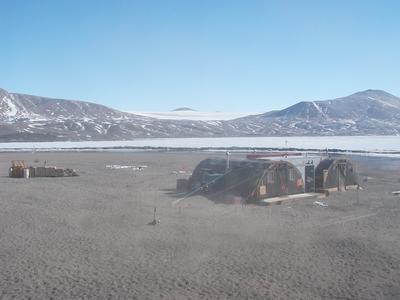
We left camp today to head back to the McMurdo Research Station on Ross Island. As we packed up gear, it was rather sad for me. Dr. Bowser's field camp at Explorers Cove in New Harbor will always hold a special place in my heart. As the helicopter lifted us above the camp, I tried to permanently etch everything in my mind: the Jamesway huts, the sea ice, the glaciers, the surrounding mountains, the Taylor Dry Valley, the moat, and Mt. Erebus. For me, the images represented the experiences that I had here, my team members, and the science taking place on this unique ice continent.

(A final look at the moat before leaving Explorers Cove)
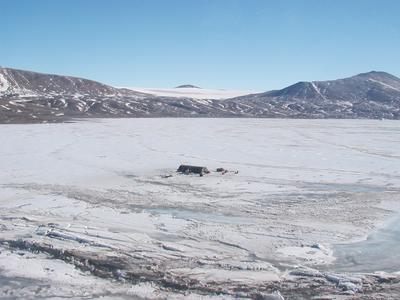
(My last view of the dive hut from the helicopter)

Traveling by helicopter gives the opportunity to see landforms from above. It was interesting to see this grounded iceberg, especially since we passed several when we drove the Ski-Doo (snowmobile) across the sea ice. The icebergs and glaciers in Antarctica are massive. Icebergs are sections of ice that break off (calve) from a glacier as the slow moving ice makes its way to the sea.
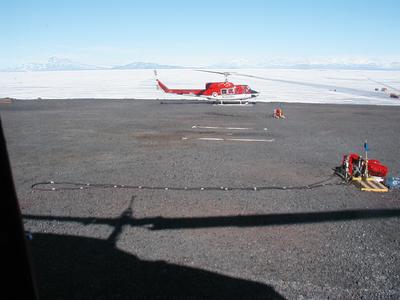
(A view from the helicopter as we landed at the helo pad in McMurdo)
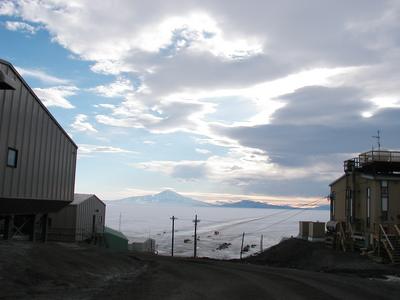
Dr. Bowser has a lab/office at the Crary Lab. The view of the Royal Society Mountain range makes a stunning backdrop for the Crary Lab.
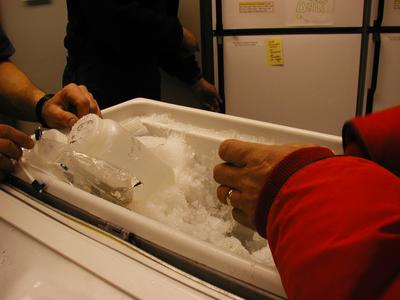
As soon as our team arrived back at the McMurdo Research Station, the foraminifera (foram) specimens were taken directly to the Crary Lab in preparation for shipment to Dr. Bowser's lab in Albany, New York. The "live" foram specimens in the container were packed in ice inside a Styrofoam container. These Antarctic forams may live in a lab setting for several years if the conditions are right. The seawater, or artificial seawater, must be kept below 6 degrees Celsius (below 42 degrees Fahrenheit) for the forams to survive. The shipped specimens will enable Dr. Bowser to continue his study of Antarctic forams, especially the Astrammina rara, from his Albany lab. Forams chemically preserved in a toxic embalming fluid will also be sent back to the lab for further analysis.

Some foram specimens were "snap frozen" (quickly frozen) in liquid nitrogen to extract their lipids (fats). This process can quickly freeze a rose to the point of shattering like glass when dropped. The chemical analysis won't be destroyed when freezing quickly in temperatures about –178 degrees Fahrenheit because the liquid nitrogen will suspend the life processes.
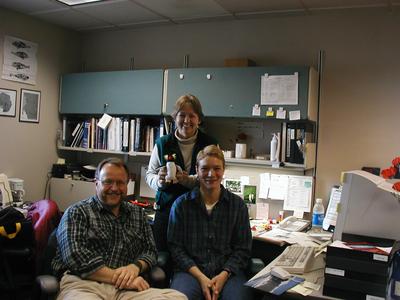
While at the lab, I stopped by the office at the Crary Lab to see Robbie Score, the Crary Lab manager (holding Spike) and Bill Sutton, the assistant supervisor for laboratory observations. Robbie Score is employed fulltime by Raytheon Polar Services (RPS). She first came to Antarctica in 1984 as a grantee (scientist) to do meteorite research. She returned again as a grantee in 1988 to do another seven week stint. Prior to running the Crary Lab, Robbie was a lab manager in Houston, Texas, for 18 years working with Antarctic meteorites. This is her 8th year to come to Antarctica. As the Crary Lab manager, she enjoys the challenges and the "problem solving" involved in helping grantees implement their science research projects in Antarctica. Due to the remoteness, the extreme cold weather conditions, and the limitations of this continent, immense planning and organization are imperative. Working in Antarctica is definitely a challenge, so imagine the effort it takes to provide continuity, as well as to meet the needs for about 80 groups coming through this lab. Robbie Score works from March to August at the Denver, Colorado, office by helping scientists order the supplies, chemicals, and equipment that will be needed for their specific research. Robbie not only helps in the planning stage, which requires orders to be placed six months in advance, but she is on-hand to see that the scientists have what they need upon their arrival in Antarctica. By working with the grantees to determine their specific needs, she is best able to plan for the season and the resources at the lab, work with the scientists, and support each group coming through the Crary Lab. She said that every day is different. This along with the science, diversity, and type of people keep her coming back to Antarctica. Bill Sutton, who is originally from Huntsville, Alabama, took a five month leave of absence from his research in Seattle, Washington. He works with Aids Vaccine Research (Protein Chemistry and Assay Development) to develop tests for looking at various molecules. This is his first time to come to Antarctica. He is contracted by Raytheon Polar Services to lend support to the grantees and to help the lab run smoothly.
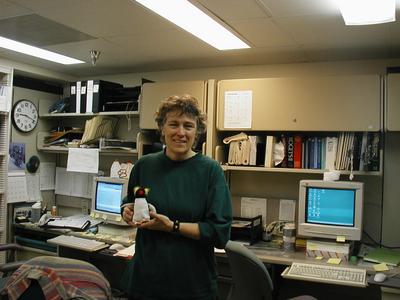
Peggy Malloy, who is contracted by Raytheon Polar Services, is a triathlon athlete who inventories all shipments as they come into the Crary Lab. She dispenses equipment and supplies to the grantees (scientists), as well as uses the computer to track and keep a record of all inventory at Crary Lab (She always knows who gets what and where it is.) Her "attention to detail" brings order to the inventoried items (science equipment, supplies, and chemicals) in the stock rooms. Since grantees must place orders well in advance, she works at Raytheon's Denver office during the off-season to help scientists order what they need for their upcoming research. Before coming to Antarctica, she worked as a medical assistant and office manager for a doctor's office. She first came to Antarctica in 1995-1996. This is her 6th season (austral spring/summer season runs from October to February) in Antarctica. She also concurs with Robbie Score by saying that no two days are alike. She, too, finds enjoyment and challenges in the variety, people, and opportunities for problem solving that comes with working in Antarctica.

Jennifer Moxon and Robbie Liben were like an oasis in a desert for me. Jennifer and Robbie were wonderful in helping me get hooked up to the computer system in McMurdo before I headed off to my field camp at Explorers Cove. They helped me establish the link needed to communicate with the outside world. Having access to a computer with Internet and email capabilities made me feel close to people thousands of miles away. Yet, when connections wouldn't go through, it also served as a reminder that I was in a very remote area at the bottom of the world. I felt fortunate to have this open line of communication. Ten years ago, this wouldn't have been possible. This is Jennifer's seventh summer season in Antarctica. She has wintered here five times. She came to Antarctica as a 20-year old computer science major from California. Her father came to Antarctica in the 1980s as a heavy machines mechanic. During the off season, Jennifer does seasonal and part-time work, or takes classes to continue her education. Robbie has come to Antarctica four times. He came in on the Winfly this season (on one of the first planes coming to the McMurdo Research Station in August). He has worked three times in McMurdo as a computer technician (guru). Last year he made four cruises on the Nathaniel B. Palmer research vessel as a network administrator. He was responsible for keeping the entire network on board ship up and running. This included the email and data acquisition system. During his off-season, Robbie works with a computer support group to aid progressive non-profit organizations for environmental organizations and human rights. His first thoughts of working in a polar region began several years ago when he was herding sheep with a Navaho family in Arizona. As he listened to the transistor radio, he heard an interview with Barry Lopez talking about his book, "Arctic Dreams". He got the book and read it, which inspired him to apply for this Antarctic position at the job fair in Denver. When he first came to Antarctica during the 1998-1999 season, he felt he had come full circle when he met Barry Lopez in McMurdo. Barry Lopez had come to Antarctica on a NSF grant for artists/ writers.
Contact the TEA in the field at
.
If you cannot connect through your browser, copy the
TEA's e-mail address in the "To:" line of
your favorite e-mail package.
|
